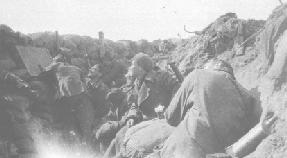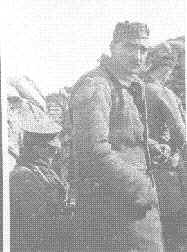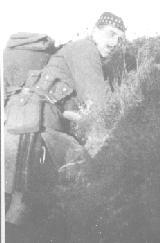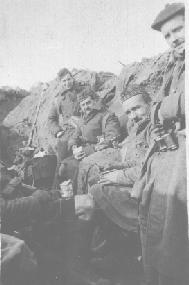Images taken in the Front Line with The
Liverpool Scottish during the early part of 1915
These photographs are part of a series which were taken in
Ypres Salient, probably in reserve trenches but very close to the
front line. The presence of cameras in the front line was
strictly forbidden but Private F.A. Fyfe, a press photographer by
profession, certainly used his miniature camera in the front line
as the rare photographs taken under fire during the charge at
Hooge in June 1915 demonstrate. The man who took these photos (very possibly
Captain R.F.B. Dickinson) must have been close to the Commanding Officer, Lt.
Col. JR Davidson, as the CO features in many of them. This series
of photos had quite a wide distribution amongst the men of the
battalion as surviving albums (including Captain Dickinson's own album) in the Museum demonstrate.
 .The
evidence of Photo 1(left - click on image to enlarge): Soldiers are in a mixture of headress
and while most men are wearing the official glengarries with the
diced (chequered) band, one is wearing the more practical woollen
'cap-comforter' which were already appearing by November 1914. A
trench periscope is being used in the centre and can be seen
sticking up over the top of parapet. To the left is a metal sheet with a slot
cut in the bottom; this is an armoured loophole to allow a rifle
to be fired with protection to the firer. There were a variety of
methods of protecting observation points and loopholes. Soldiers
appear to be watching to their front and to a point above them; a
rifle grenade is being fired by the man in the right foreground
who is, in fact, the Commanding Officer, Lt Colonel Davidson, whose diary says
that on the 20th March 1915, he went up to Trench 38 at Hill 60, inspected a new
loophole that he had had made and and fired about 12 rifle grenades with a 'very
fair degree of success'. Left to right the
personalities are Capt. CP James (Adjutant and observing through
armoured slit), Capt. AS Anderson (Company Commander), an unknown
private, Lt. Kenneth Gemmell and Lt Col JR Davidson. A water
bottle can be seen to the bottom right; supplies of drinking
water were a great problem particularly in the early days of
trench warfare when there were very few communication trenches.
.The
evidence of Photo 1(left - click on image to enlarge): Soldiers are in a mixture of headress
and while most men are wearing the official glengarries with the
diced (chequered) band, one is wearing the more practical woollen
'cap-comforter' which were already appearing by November 1914. A
trench periscope is being used in the centre and can be seen
sticking up over the top of parapet. To the left is a metal sheet with a slot
cut in the bottom; this is an armoured loophole to allow a rifle
to be fired with protection to the firer. There were a variety of
methods of protecting observation points and loopholes. Soldiers
appear to be watching to their front and to a point above them; a
rifle grenade is being fired by the man in the right foreground
who is, in fact, the Commanding Officer, Lt Colonel Davidson, whose diary says
that on the 20th March 1915, he went up to Trench 38 at Hill 60, inspected a new
loophole that he had had made and and fired about 12 rifle grenades with a 'very
fair degree of success'. Left to right the
personalities are Capt. CP James (Adjutant and observing through
armoured slit), Capt. AS Anderson (Company Commander), an unknown
private, Lt. Kenneth Gemmell and Lt Col JR Davidson. A water
bottle can be seen to the bottom right; supplies of drinking
water were a great problem particularly in the early days of
trench warfare when there were very few communication trenches.
The Liverpool Scottish had arrived in France at the beginning
of November 1914, one of the first infantry battalions of the
Territorial Force to join the British Expeditionary Force. They
arrived in the period almost immediately after the 'Old
Contemptibles' of Regular Army (a 'contemptible little army'
according to the German Kaiser Wilhelm) had fought alongside the
French and the Belgians in a highly mobile battle with a retreat
from Mons to a sharp blocking battle at Le Cateau and beyond to a
final phase of checking and throwing back the German advance on
the River Marne. The Liverpool Scottish came into the 3rd
Division of II Corps (a Regular Army formation) and was initially
addressed by the Corps Commander, General Sir H. Smith Dorrien,
to the effect that, with the co-operation of the Russians, the
war would be over by the summer of 1915. The Regimental Historian
records that newly-arrived citizen soldiers of The Scottish 'were
surprised to learn that the Staff expected the war to last so
long'.
 The
evidence of Photo 2
(left - click on image to enlarge): this shows a sandbagged trench. Sandbags were difficult
to come by in 1914 so this suggests a later date. As the
glengarry with diced (chequered) banding is still the headress of
choice but soldiers are still in gloves and greatcoats, this
suggests Spring 1915. The soldier to the left in the standard
peaked cap is not of The Liverpool Scottish but may be a member
of an English battalion coming into or going out of the trenches
or possibly Lt Kidson RAMC. The 'relief' of one battalion by
another was a difficult operation, normally conducted at night.
Alternatively he might be one of the few Army Service Corps or
Medical Corps soldiers attached to the battalion although the
binoculars and the location in what appears to be the front line
make this unlikely. This particular soldier is well wrapped up
against the cold by his scarf; the binoculars that he carries may
indicate that he is an officer or a senior NCO. The other officer
is the company commander, Capt AS Anderson.
The
evidence of Photo 2
(left - click on image to enlarge): this shows a sandbagged trench. Sandbags were difficult
to come by in 1914 so this suggests a later date. As the
glengarry with diced (chequered) banding is still the headress of
choice but soldiers are still in gloves and greatcoats, this
suggests Spring 1915. The soldier to the left in the standard
peaked cap is not of The Liverpool Scottish but may be a member
of an English battalion coming into or going out of the trenches
or possibly Lt Kidson RAMC. The 'relief' of one battalion by
another was a difficult operation, normally conducted at night.
Alternatively he might be one of the few Army Service Corps or
Medical Corps soldiers attached to the battalion although the
binoculars and the location in what appears to be the front line
make this unlikely. This particular soldier is well wrapped up
against the cold by his scarf; the binoculars that he carries may
indicate that he is an officer or a senior NCO. The other officer
is the company commander, Capt AS Anderson.
By November 1914, the Regular Army had suffered many
casualties and the battle had settled into the pattern of trench
warfare that was to persist for most the next four years. The
Scottish moved into the trenches on 27th November at Kemmel,
about six miles south-west of Ypres (Ieper). The trench system at
that stage was very haphazard and not the structured system of ,
say, 1916. There was no depth, no continuity, no communication
trenches, no drainage and no sanitation. On Novermber 27th 1914
the battalion was 26 officers and 829 other ranks and six weeks
later mustered only a total strength of 370 men. Soldiers came
from Liverpool wearing shoes and spats as the standard Highland
leg dress. In the conditions of the trenches a soldier could find
that his shoe and his spat had been sucked from his numbed leg by
the mud without being noticed.
 The
evidence of Photo 3 (above right - click on image to enlarge) Whilst identification is very difficult
when the clipped military moustache was so common and everyone is
dressed similarly, albums in the possession of the museum identify
this soldier as L/Cpl JCT Nisbet who was later killed in action
before he had the chance to take up the commission which would
have made him a 'commissioned' officer. He looks rather smarter,
cleaner and less tired than some in this series of photos. . His
kit is neatly arranged and it would appear that a groundsheet or
poncho is neatly folded onto his pack. The grassy bank might
suggest that this is not in the front line or that the photograph
has been posed.
The
evidence of Photo 3 (above right - click on image to enlarge) Whilst identification is very difficult
when the clipped military moustache was so common and everyone is
dressed similarly, albums in the possession of the museum identify
this soldier as L/Cpl JCT Nisbet who was later killed in action
before he had the chance to take up the commission which would
have made him a 'commissioned' officer. He looks rather smarter,
cleaner and less tired than some in this series of photos. . His
kit is neatly arranged and it would appear that a groundsheet or
poncho is neatly folded onto his pack. The grassy bank might
suggest that this is not in the front line or that the photograph
has been posed.
The battalion's doctor, Captain Noel Chavasse, took a lead in
devising strategies to cope with trench foot and the 'Q'
(quartermaster) element of the battalion developed innovative
procedures for feeding men in the trenches such as the division
of rations into bagged portions for groups of men so as to ease
the problems of distribution. This may seem obvious but at the
time it was revolutionary.
- The Evidence of Photo 4 (above left - click on
image to enlarge)
- The soldier whose leg is
in the foreground seems to be wearing boots and puttees
which have replaced the totally unsuitable shoes and
spats that The Liverpool Scottish originally wore when
they joined the B.E.F. Boots seem to be remarkably clean
and this would appear to be a dry sector.
- The group seems to be
enjoying a meal, an open can rests on the kilted knee and
another can is in the centre. One of the standard canned
rations was the 'Maconochie Patent Ration' which was a 26
ounce can (about three quarters of a kilo or 750 grammes)
of unspecified meat and vegetable. The Army Service Corps
manual of 1914 says that the contents can 'be eaten hot
or cold but are much more palatable hot'. Lack of hot
food in the trenches at Kemmel was thought to be a
contributory factor to the high rate of sickness in the
first winter of the war; it was only possible to bring up
hot tea at night often over distances of over a mile and
over bad ground for it to arrive lukewarm. Here the
trenches appear dry and this photograph might originate
from the period after March 1915 when the battalion moved
into the Ypres Salient.
- On the left of the man in
the background (as seen by the viewer), there appears to
be a rifle with a fixed bayonet; it would seem to be the
old 'long' Lee Enfield with which the battalion was
initially equipped and which was unsuitable for trench
conditions in that its long barrel was easily fouled with
mud and it required non-standard Mark VI ammunition
whilst the general issue was Mark VII. The regular Army
had the SMLE (short, magazine, Lee Enfield) and this was
not issued to the battalion until early 1915. However,
drafts from the UK and men who had been detached from the
battalion would continue for some time to report back for
duty equipped with the cumbersome 'long' rifle.
- Another point of interest
is the man in the right foreground who is wearing a
balmoral or Tam o'Shanter (TOS) bonnet. The glengarry was
gradually replaced and had disappeared by 1916. Men wore
the woollen cap comforter or the TOS which evolved into
its pancake form during the war. The modern TOS is a much
briefer and more smartly tailored affair based upon the
Lowland bonnet.
- In this picture the
personalities are (L to R) Lt JC Barber, Pte HD Ryalls,
Pte Lindsay and Pte JR Pollock (destined to win the
Military Medal on three occasions during the war, an
exceptional distinction).
 .The
evidence of Photo 1(left - click on image to enlarge): Soldiers are in a mixture of headress
and while most men are wearing the official glengarries with the
diced (chequered) band, one is wearing the more practical woollen
'cap-comforter' which were already appearing by November 1914. A
trench periscope is being used in the centre and can be seen
sticking up over the top of parapet. To the left is a metal sheet with a slot
cut in the bottom; this is an armoured loophole to allow a rifle
to be fired with protection to the firer. There were a variety of
methods of protecting observation points and loopholes. Soldiers
appear to be watching to their front and to a point above them; a
rifle grenade is being fired by the man in the right foreground
who is, in fact, the Commanding Officer, Lt Colonel Davidson, whose diary says
that on the 20th March 1915, he went up to Trench 38 at Hill 60, inspected a new
loophole that he had had made and and fired about 12 rifle grenades with a 'very
fair degree of success'. Left to right the
personalities are Capt. CP James (Adjutant and observing through
armoured slit), Capt. AS Anderson (Company Commander), an unknown
private, Lt. Kenneth Gemmell and Lt Col JR Davidson. A water
bottle can be seen to the bottom right; supplies of drinking
water were a great problem particularly in the early days of
trench warfare when there were very few communication trenches.
.The
evidence of Photo 1(left - click on image to enlarge): Soldiers are in a mixture of headress
and while most men are wearing the official glengarries with the
diced (chequered) band, one is wearing the more practical woollen
'cap-comforter' which were already appearing by November 1914. A
trench periscope is being used in the centre and can be seen
sticking up over the top of parapet. To the left is a metal sheet with a slot
cut in the bottom; this is an armoured loophole to allow a rifle
to be fired with protection to the firer. There were a variety of
methods of protecting observation points and loopholes. Soldiers
appear to be watching to their front and to a point above them; a
rifle grenade is being fired by the man in the right foreground
who is, in fact, the Commanding Officer, Lt Colonel Davidson, whose diary says
that on the 20th March 1915, he went up to Trench 38 at Hill 60, inspected a new
loophole that he had had made and and fired about 12 rifle grenades with a 'very
fair degree of success'. Left to right the
personalities are Capt. CP James (Adjutant and observing through
armoured slit), Capt. AS Anderson (Company Commander), an unknown
private, Lt. Kenneth Gemmell and Lt Col JR Davidson. A water
bottle can be seen to the bottom right; supplies of drinking
water were a great problem particularly in the early days of
trench warfare when there were very few communication trenches.

